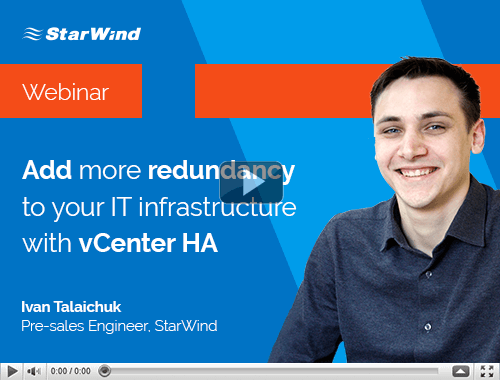VMware vCenter High Availability is a feature included in vSphere 6.5 and delivers an RTO of about 5 minutes and automatic failover, significantly reducing the impact of host, hardware, and application failures.
The vCenter HA (VCHA) architecture setup consists of three nodes: Active, Passive and Quorum. The Active node is a production VM serving administrators’ requests and providing general services and operations within the vSphere environment. The Passive node is an exact copy of the Active node, which constantly receives updates from it and has the same size. The Quorum (Witness) node serves to solve split-brain scenarios and inconsistencies within the distributed system which has replicated data between nodes.
The architecture includes two networks. The first one is a private network, or Ethernet1, between the nodes, which serves to transfer private traffic, like heartbeats, synchronizations, and file replications. The second one is Ethernet0 which sends the management network to the clients. VMware vCenter Server can be configured with embedded or external Platform Services Controller (PSC).
The embedded configuration is sufficient for most environments. It is easy to maintain and deploy and supports up to eight vCenter Servers. Under such configuration, the vCenter Server and PSC are deployed on the same virtual machine.
For larger infrastructures, with a significant amount of vCenter Servers, it is recommended to deploy the external configuration which supports both vCenter Server Appliance (VCSA) and vCenter Server on Windows. The vCenter Server and PSC are deployed on different virtual machines. This is necessary when multiple vCenter Servers are in linked mode and communicating via a single PSC.
vCenter Server performance depends on how big is the environment and on the number of vCenter Servers located on the host.
In the case of a failure, vCenter HA provides the failover which allows users to continue their work in less than 2 minutes through API clients and less than 4 minutes through UI clients. Additionally, when VCHA is enabled, there is no significant impact on vCenter Server under typical workload conditions.


